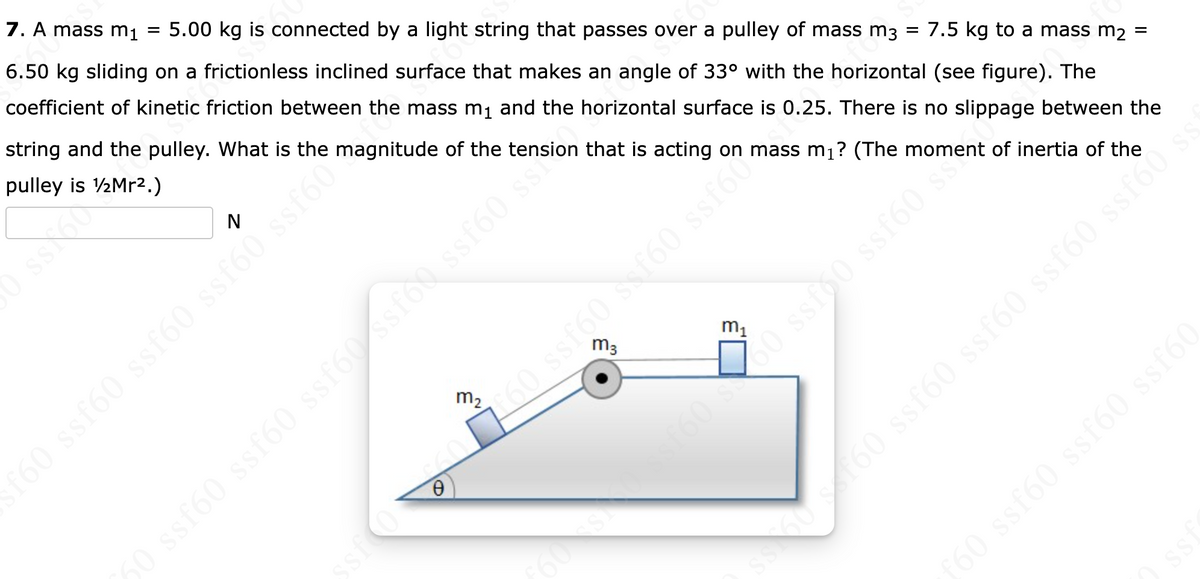7. A mass m₁ = 5.00 kg is connected by a light string that passes over a pulley of mass m3 = 7.5 kg to a mass m₂ = 6.50 kg sliding on a frictionless inclined surface that makes an angle of 33° with the horizontal (see figure). The coefficient of kinetic friction between the mass m₁ and the horizontal surface is 0.25. There is no slippage between the string and the pulley. What is the magnitude of the tension that is acting on mass m₁? (The moment of inertia of the pulley is 1/2Mr².) N ssf60 f60 ss? ssf60 sf60 sse 50 ssf60
7. A mass m₁ = 5.00 kg is connected by a light string that passes over a pulley of mass m3 = 7.5 kg to a mass m₂ = 6.50 kg sliding on a frictionless inclined surface that makes an angle of 33° with the horizontal (see figure). The coefficient of kinetic friction between the mass m₁ and the horizontal surface is 0.25. There is no slippage between the string and the pulley. What is the magnitude of the tension that is acting on mass m₁? (The moment of inertia of the pulley is 1/2Mr².) N ssf60 f60 ss? ssf60 sf60 sse 50 ssf60
Physics for Scientists and Engineers with Modern Physics
10th Edition
ISBN:9781337553292
Author:Raymond A. Serway, John W. Jewett
Publisher:Raymond A. Serway, John W. Jewett
Chapter6: Circular Motion And Other Applications Of Newton's Laws
Section: Chapter Questions
Problem 11P
Related questions
Topic Video
Question

Transcribed Image Text:7. A mass m₁ = 5.00 kg is connected by a light string that passes over a pulley of mass m3 = 7.5 kg to a mass m2
6.50 kg sliding on a frictionless inclined surface that makes an angle of 33° with the horizontal (see figure). The
coefficient of kinetic friction between the mass m₁ and the horizontal surface is 0.25. There is no slippage between the
string and the pulley. What is the magnitude of the tension that is acting on mass m₁? (The moment of inertia of the
pulley is 1/2Mr².)
f60 ssf60 ssf60 ssf60 ssf60
0
m₂
ssf60 ssf60 ssf60 ssfóossf60 s
m₁
0 ssf60 s f60 ssfooms
oss is
=
ss mojss (9jss (9Jss is 1919
ISS
f60 ssf60 ssf60 ssf60
Expert Solution
This question has been solved!
Explore an expertly crafted, step-by-step solution for a thorough understanding of key concepts.
Step by step
Solved in 4 steps with 4 images

Knowledge Booster
Learn more about
Need a deep-dive on the concept behind this application? Look no further. Learn more about this topic, physics and related others by exploring similar questions and additional content below.Recommended textbooks for you

Physics for Scientists and Engineers with Modern …
Physics
ISBN:
9781337553292
Author:
Raymond A. Serway, John W. Jewett
Publisher:
Cengage Learning

Principles of Physics: A Calculus-Based Text
Physics
ISBN:
9781133104261
Author:
Raymond A. Serway, John W. Jewett
Publisher:
Cengage Learning

Physics for Scientists and Engineers
Physics
ISBN:
9781337553278
Author:
Raymond A. Serway, John W. Jewett
Publisher:
Cengage Learning

Physics for Scientists and Engineers with Modern …
Physics
ISBN:
9781337553292
Author:
Raymond A. Serway, John W. Jewett
Publisher:
Cengage Learning

Principles of Physics: A Calculus-Based Text
Physics
ISBN:
9781133104261
Author:
Raymond A. Serway, John W. Jewett
Publisher:
Cengage Learning

Physics for Scientists and Engineers
Physics
ISBN:
9781337553278
Author:
Raymond A. Serway, John W. Jewett
Publisher:
Cengage Learning